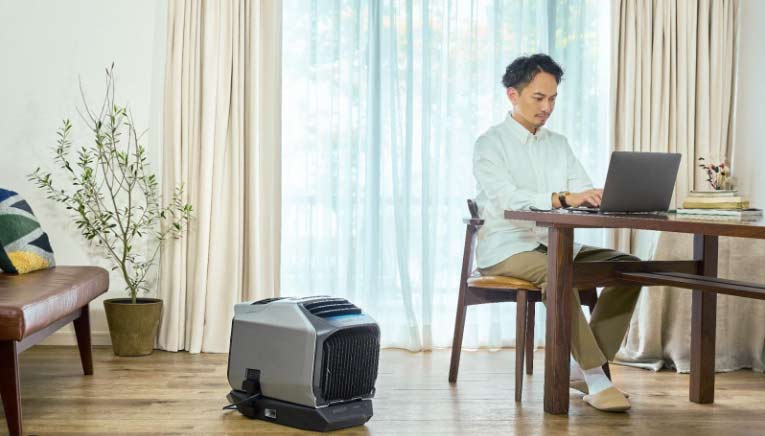Portable Air Conditioners: How to Choose the Right One for Your Home or Office
Portable air conditioners have become increasingly popular due to their versatility and convenience. Whether you’re looking to cool a small home office or an entire living space, selecting the right portable air conditioner can make a significant difference in comfort and energy efficiency.

Key Factors to Consider When Choosing a Portable Air Conditioner
When selecting a portable air conditioner, it’s important to consider several factors to ensure it meets your cooling needs and is energy efficient:
- Room Size: The cooling capacity of portable air conditioners is measured in BTUs (British Thermal Units). Larger rooms require units with higher BTU ratings.
- Energy Efficiency: Look for units with a high Energy Efficiency Ratio (EER) to save on electricity bills.
- Noise Level: If you’re sensitive to noise or planning to use the air conditioner in a quiet space, consider the noise level, typically measured in decibels (dB).
- Portability: Check the weight and the presence of wheels or handles for easy movement between rooms.
- Additional Features: Some models come with additional features like dehumidifiers, timers, remote controls, and smart connectivity.
Top 10 Portable Air Conditioner Companies in the US
Here’s a comparison of some of the leading portable air conditioner brands available in the United States:
| Company | Model | BTU Rating | Energy Efficiency | Noise Level | Price Range | Key Features |
|---|---|---|---|---|---|---|
| Honeywell | MN10CESWW | 10,000 | 9.5 EER | 53 dB | $400-$450 | Dehumidifier, 3 Fan Speeds, Remote Control |
| LG | LP1419IVSM | 14,000 | 10.5 EER | 44 dB | $550-$650 | Dual Inverter, Wi-Fi Enabled, Low Noise |
| Whynter | ARC-14S | 14,000 | 11.2 EER | 56 dB | $450-$500 | Dual Hose, Eco-Friendly Refrigerant, Dehumidifier |
| Black + Decker | BPACT08WT | 8,000 | 8.9 EER | 50 dB | $300-$350 | Compact Design, LED Display, Remote Control |
| Frigidaire | FGPC1044U1 | 10,000 | 10 EER | 55 dB | $450-$500 | Sleep Mode, Remote Control, Air Purifier |
| DeLonghi | PACEM360 WH | 12,000 | 9.8 EER | 52 dB | $500-$600 | Eco Real Feel, Silent Mode, BioSilver Filter |
| SereneLife | SLPAC10 | 10,000 | 8.7 EER | 57 dB | $250-$300 | Built-in Dehumidifier, Remote Control, Compact |
| GE | APCD08JASG | 8,000 | 9.0 EER | 54 dB | $350-$400 | Auto Evaporation Technology, Digital Controls |
| Shinco | SPF2-08C | 8,000 | 8.5 EER | 55 dB | $250-$300 | Quick Installation, Dehumidifier, Remote Control |
| Haier | HPP08XCR | 8,000 | 9.0 EER | 52 dB | $300-$350 | Easy Roll Casters, 3 Fan Speeds, Remote Control |
Frequently Asked Questions (FAQs)
Q: What size portable air conditioner do I need for my room?
A: The size of the portable air conditioner needed depends on the room’s square footage. Generally, a room of 150-350 square feet requires a unit with 5,000-8,000 BTUs, while larger rooms up to 600 square feet might need a unit with 12,000-14,000 BTUs.
Q: Are portable air conditioners energy efficient?
A: Portable air conditioners can be energy efficient, especially those with high Energy Efficiency Ratios (EER). Models with features like dual-hose systems and inverter technology also offer better efficiency by reducing power consumption.
Q: How noisy are portable air conditioners?
A: Noise levels vary among models, typically ranging from 50 dB (about the noise level of a conversation) to 60 dB (similar to background music). If noise is a concern, look for models with a “quiet mode” or those specifically marketed as low-noise units.
Q: Do portable air conditioners need to be vented?
A: Yes, most portable air conditioners need to be vented to expel hot air outside. This is typically done using an exhaust hose connected to a window kit. Some models may have different venting options, so it’s essential to follow the manufacturer’s instructions.
Q: Can a portable air conditioner be used in any room?
A: While portable air conditioners can be used in most rooms, it’s important to ensure the room has a window or an opening for venting. Additionally, the unit should be placed on a flat surface and away from obstructions for optimal airflow.
Tips for Choosing the Right Portable Air Conditioner
- Measure Your Space: Before purchasing, measure the room where you plan to use the air conditioner to ensure you choose the right BTU rating.
- Check for Energy Efficiency: Opt for models with higher EER ratings to save on energy costs over time.
- Consider Noise Levels: If you need a quiet environment, such as a bedroom or home office, choose models with lower decibel ratings.
- Look for Portability Features: Ensure the unit has wheels or handles if you plan to move it between rooms.
- Review Additional Features: Features like remote controls, programmable timers, and dehumidifiers can add convenience and comfort.
Real-World Example
One popular model is the LG LP1419IVSM, which offers 14,000 BTUs and a high EER of 10.5, making it ideal for larger rooms or offices up to 500 square feet. Priced around $600, it features a dual inverter for quieter operation (44 dB) and energy efficiency. Users have praised this model for its smart features, including Wi-Fi connectivity, allowing control via smartphone apps.
Conclusion
Choosing the right portable air conditioner involves considering factors like room size, energy efficiency, noise levels, and additional features. With numerous options available, it’s important to compare different models to find one that best fits your needs and budget.
References
- https://www.consumerreports.org/cro/air-conditioners.htm
- https://www.energy.gov/energysaver/home-cooling-systems/portable-air-conditioners
- https://www.lg.com/us/portable-air-conditioners/lg-LP1419IVSM-portable-air-conditioner
These sources provide additional insights into choosing the right portable air conditioner and offer reviews of various models available in the market.







Recent Comments